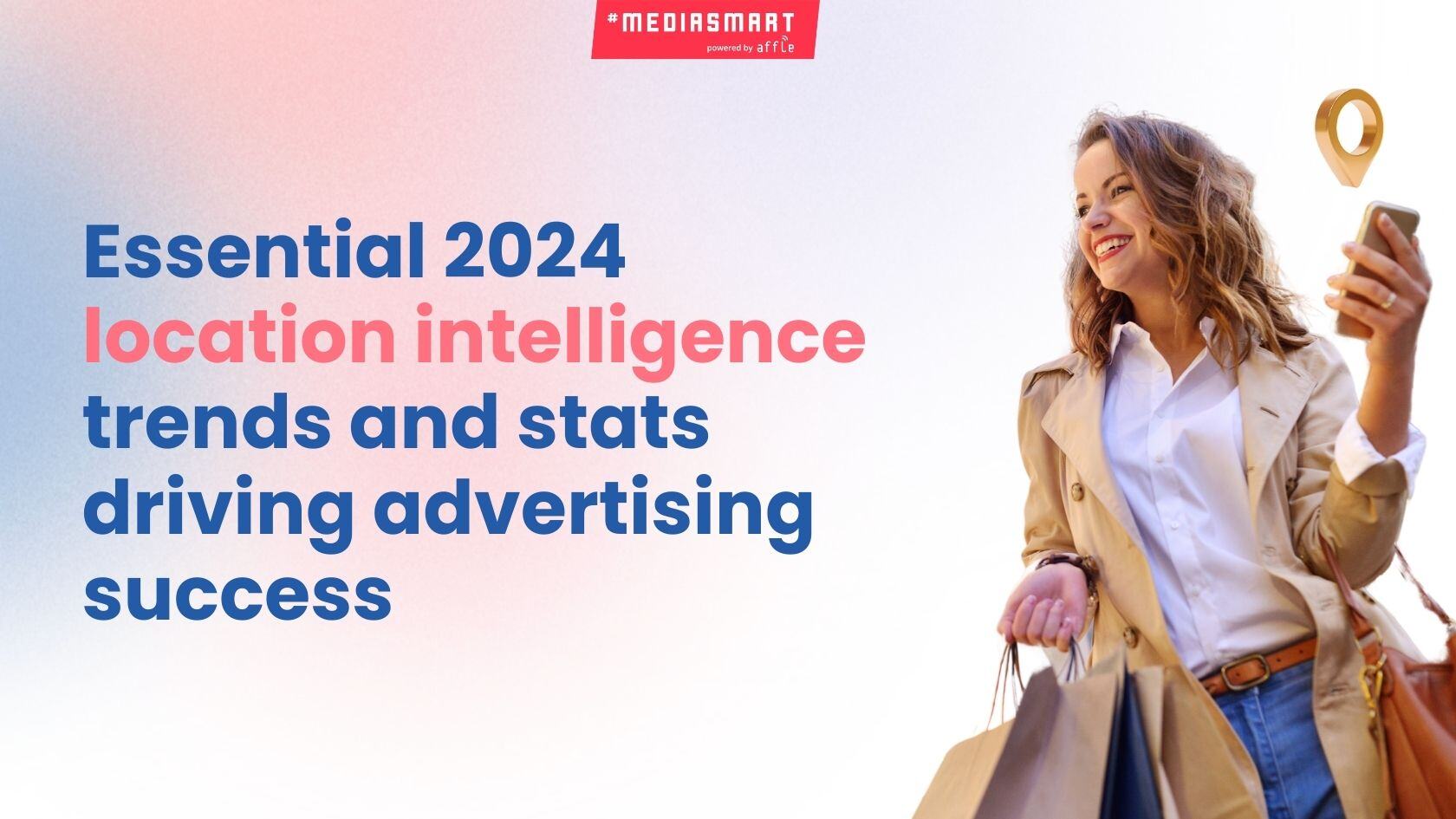Blog
Announcements, analysis and opinions on industry trends around the mobile programmatic world.

Subscribe now, and receive the latest programmatic content directly on your inbox!
Thank you for subscribing to our newsletter
Essential 2024 location intelligence trends and stats driving advertising success

The end of 2024 is here, and the shopping season is set to hit record highs, with holiday retail sales expected to reach $1.372 trillion1. Brands are using real-time location data to make serious moves during the festive rush. If you’re in the ad game, location intelligence should be your secret weapon. Let us quickly explore what Geospatial or Location-based advertising is, before diving into key stats and trends. Ready to dive in?
Geospatial advertising explained
Geospatial advertising uses real-time location data to deliver contextually relevant ads. Advertisers can create location-based audiences, and engage users in specific areas with personalized messages that drive foot traffic and improve campaign effectiveness.

Dive into our guides and discover more:
> Location intelligence in action: boosting advertising relevance
> Maximizing Shopping season success with Location Intelligence
> Drive-to-store advertising
Key Location intelligence stats for the 2024 Shopping season
Understanding location trends is vital for marketers, this year brings unique insights into consumer behavior. Whether you're a brick-and-mortar store or an online retailer, these insights will help you optimize your approach:

> Retailers have improved marketing efficiency by 20% using location-based targeting (Deloitte).
> 31% of retailers report challenges aligning eCommerce and in-store touchpoints, highlighting opportunities for cohesive programmatic ad strategies (Mastercard).
> 71% of consumers now expect personalized shopping experiences, and retailers are leveraging geospatial data to deliver them (Deloitte).
While shoppers expect a personalized touch, many marketers are still figuring out how to sync online and in-store efforts. This a great time to rethink marketing strategies by leveraging both geospatial data and programmatic technology.
2024 trends and strategies for holiday success with location data
Geofencing and hyperlocal promotions to connect with mobile-first shoppers
With mobile-driven e-commerce set to grow by 9.5% in 2024, accounting for $271.58 billion in sales1, it’s clear that shoppers are turning to their phones more than ever. In regions like Southeast Asia, where 81% of consumers make purchases via mobile3, and in India, where 43% of holiday shoppers opt for mobile purchases4, geofencing is a powerful tool.
By setting up virtual boundaries - also known as targeting areas - around stores or high-traffic areas, brands can instantly deliver personalized offers when a shopper enters a specific location. Imagine targeting consumers near your store with exclusive deals as they walk by during a holiday… This is the perfect opportunity to capitalize on the 200% growth 5 in mobile search for "Black Friday deals".
Location-based audience segmentation: Target the most relevant groups when it matters
In Brazil, where hybrid shopping is growing and 45% of shoppers plan to mix physical and digital experiences6, brands need to differentiate between online and in-store customers. And LATAM isn’t the only region where hybrid shopping is becoming the norm: 73% of Southeast Asians7 and 54% of Indian8 consumers prefer mixed in-store and online experiences.
Segmented, location-based audiences will give you a competitive edge, making sure your ads are reaching the most relevant audiences at the right time. You can automatically target users seen in a certain radius around your stores on other locations, block users who have visited you, or even reach out with a particularly aggressive offer to your competitor’s store visitors. Let us learn more about that scenario.
Steal the spotlight with location insights: Competitor shopper targeting
If a shopper is browsing at a rival location, you can reach out with a personalized discount or limited-time offer, in real-time or later—encouraging them to choose your store instead. This strategy can be particularly effective with Holiday shoppers who are always on the lookout for the best deals. In regions like Southeast Asia, 75% of consumers across the region confess they keep a close eye on promotions throughout the season9.
Brands can steal their competitors’ spotlight by targeting audiences near competitors’ stores with better deals or even with more flexible payment options. The "Buy Now, Pay Later" (BNPL) model is expected to hit $993 million globally on Cyber Monday alone. But how can we ensure the strategy is being effective?
Drive-to-store: Boost foot traffic and measure results
With consumers increasingly blending online and offline shopping, Drive-to-store campaigns are essential for turning online engagement into in-store visits.
By using location insights, brands can send personalized ads to nearby consumers and then track how many people visit their store after seeing the ads. This not only improves ROI but also aligns with the growing trend of hybrid shopping across markets like Brazil6 and India8, where seamless transitions between digital and physical experiences are key. Brands using location-based advertising saw up to a 20% increase in in-store conversions10. With that established, how do advertisers design ads that grab attention?
Dynamic creatives: Use real-time geospatial data to personalize ads
Real-time factors like weather and location provide brands with unique opportunities to tailor their messaging. Dynamic creatives allow you to push relevant ads based on live conditions. For example, if it’s raining, promote indoor products like cozy home goods, and if it’s sunny, push outdoor gear and activities. Add directions to your closest stores or even a map within the ad.
This strategy taps into the power of personalized advertising, which is crucial as 71% of consumers now expect personalized shopping experiences10. Tailoring your ads to their current environment makes your messaging more relevant and increases engagement.
Smart wrap up
As the season heats up, keep mobile at the forefront, and offer flexible payment options to gain traction. Leveraging location data, engage shoppers in real-time, to deliver the right message at the right moment—whether users are searching for deals on their phones or browsing near your store.
By using geofencing, audience segmentation, competitor targeting, drive-to-store campaigns, and dynamic creatives, you can deliver personalized experiences that resonate with today’s holiday shoppers. Learn more about shopping season data or contact us to start today!
Sources
1 Guide to Holiday Retail | eMarketer
2 2023 Retail TouchPoints Report | Mastercard
3 Spending in Southeast Asia Will Be 'Skyrocketing' This Holiday Season Says Report | Branding in Asia
4 Financial Express
5 Holiday search & shopping trends | Google
6 Faturamento na Black Friday deve crescer 10% em 2024 | E-Commerce Brasil
7 Six out of ten Southeast Asians plan to increase online shopping budgets for the holidays: report - Marketech APAC
8 Festive marketing in 2023 | The Drum
9 Holiday sales season marketing strategy | Google
10 Geospatial Analytics use cases | Deloitte Insights
Topics: Geolocation, market trends, hyperlocation, festive marketing, location intelligence in advertising, hyper-local targeting, Industry Trends
%20(1).jpg)
